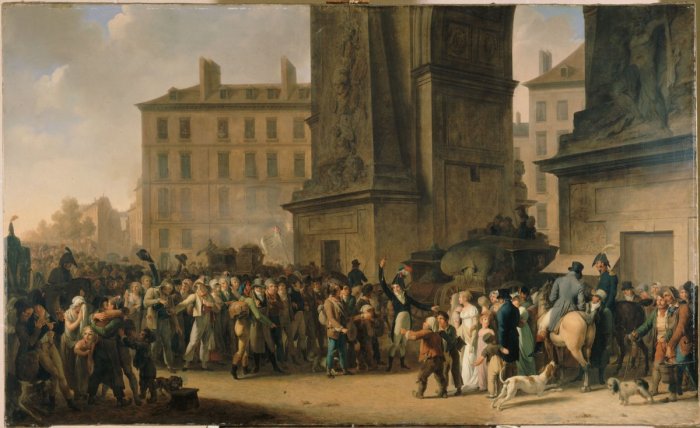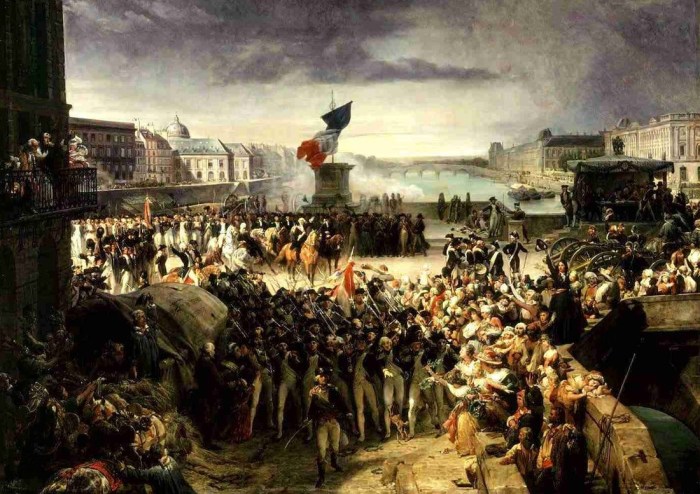Levee en masse french revolution – Levée en masse, the French Revolution’s radical mobilization effort, stands as a pivotal moment in history, leaving an enduring legacy on warfare and societal transformation. This comprehensive analysis delves into the concept, implementation, impact, and significance of this extraordinary measure.
Driven by the exigencies of war and fueled by revolutionary fervor, the levee en masse transformed French society, empowering the masses while challenging traditional military norms. Its far-reaching effects reverberated throughout the Revolution, shaping its course and leaving an indelible mark on the nation’s history.
Definition and Origin of Levee en Masse

Levée en masse, a French term meaning “levy in mass,” refers to the widespread conscription of citizens into military service, typically during times of national crisis or war.
During the French Revolution, the concept of levee en masse gained prominence as a radical and unprecedented measure to mobilize the entire population against foreign threats. The revolutionary government implemented this policy in response to the threat posed by the allied forces of Austria and Prussia, who sought to restore the monarchy and suppress the revolution.
Factors Leading to the Implementation of Levée en Masse
Several factors contributed to the decision to implement levee en masse during the French Revolution:
- Imminent Threat:The threat of invasion by foreign powers loomed large, posing an existential danger to the young republic.
- Revolutionary Fervor:The revolutionary government and its supporters were driven by a sense of urgency and a belief that the defense of the revolution was a sacred duty.
- Shortage of Soldiers:The French army was severely undermanned, and traditional methods of recruitment were proving inadequate.
- Popular Support:The concept of levee en masse resonated with the French people, who were eager to defend their newly won freedoms.
Implementation and Impact

The levee en masse was implemented through a series of decrees issued by the French National Convention in 1793. These decrees required all able-bodied men between the ages of 18 and 25 to register for military service. The process of registration and conscription was carried out by local authorities, who were responsible for compiling lists of eligible men and organizing their departure for training camps.
The levee en masse had a profound impact on French society. It led to the mobilization of hundreds of thousands of men, who were sent to fight on the front lines of the French Revolutionary Wars. The war effort required a massive increase in the production of food, clothing, and other supplies, which in turn stimulated the French economy.
The levee en masse also had a significant impact on the political landscape of France. It led to the rise of a new generation of military leaders, who would play a key role in the subsequent history of France.
Military Impact
- The levee en masse led to a dramatic increase in the size of the French army. In 1792, the French army had approximately 250,000 men under arms. By 1794, the army had grown to over 1 million men.
- The levee en masse also led to a change in the composition of the French army. Prior to the levee en masse, the French army was composed primarily of professional soldiers. However, after the levee en masse, the army was composed largely of conscripts who had little or no military experience.
- The levee en masse had a significant impact on the tactics and strategies used by the French army. The large number of conscripts in the army meant that the French were able to adopt a more aggressive and offensive style of warfare.
Political Impact, Levee en masse french revolution
- The levee en masse led to the rise of a new generation of military leaders. These leaders, such as Napoleon Bonaparte, were not from the traditional aristocracy. They rose through the ranks based on their merit and ability.
- The levee en masse also led to a shift in the balance of power within the French government. The military became more powerful and influential, while the civilian government became weaker.
- The levee en masse had a significant impact on the course of the French Revolution. It helped the French to win a series of victories against their enemies and to establish the French Republic.
Resistance and Challenges: Levee En Masse French Revolution

The implementation of levee en masse faced significant resistance and challenges. One major obstacle was the reluctance of many peasants to leave their homes and livelihoods to fight. They feared for their families, property, and crops. Additionally, the government’s attempts to conscript men into the army led to widespread evasion and desertion.
Social and Economic Consequences
Levee en masse had severe social and economic consequences for the French population. The mobilization of millions of men disrupted families and communities. Women and children were left to manage farms and businesses, often with little support. The absence of so many able-bodied men also led to labor shortages and a decline in agricultural production.
Comparison with Other Revolutions

The levee en masse stands out as a revolutionary mobilization strategy, distinguishing itself from similar efforts in other revolutions.
In the American Revolution, the Continental Army relied heavily on volunteers and militia forces, lacking a centralized conscription system. While the Russian Revolution also employed mass mobilization, it emerged later and was influenced by the French Revolution’s example.
Unique Aspects of Levee en Masse
- Nationwide Conscription:The levee en masse enforced mandatory military service for all able-bodied men, ensuring a vast and reliable pool of soldiers.
- Mass Scale:The scale of mobilization was unprecedented, with millions of citizens called to arms, reflecting the revolutionary fervor and the perceived threat to the nation.
- Ideological Underpinnings:The levee en masse was rooted in the revolutionary ideals of citizen participation and defense of the republic, fostering a sense of national unity and purpose.
Significance in the French Revolution
- Sustained Military Campaigns:The levee en masse enabled the French armies to wage prolonged and large-scale campaigns against European powers, contributing to the revolution’s military successes.
- Revolutionary Transformation:The mass mobilization transformed French society, blurring class distinctions and creating a new social order based on military service and republican values.
- Legacy for Future Revolutions:The levee en masse served as a model for subsequent revolutionary movements, influencing the development of modern conscription systems.
FAQ Corner
What was the primary objective of the levee en masse?
To rapidly expand the French military by conscripting able-bodied men to meet the demands of the Revolutionary Wars.
How did the levee en masse impact French society?
It disrupted traditional social hierarchies, empowered ordinary citizens, and fostered a sense of national unity.
What were the challenges faced in implementing the levee en masse?
Resistance from reluctant conscripts, logistical difficulties, and the need to balance military needs with economic stability.
How did the levee en masse differ from previous mobilization efforts?
Its unprecedented scale, compulsory nature, and focus on mass participation.